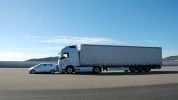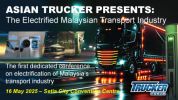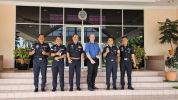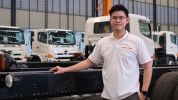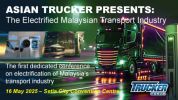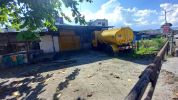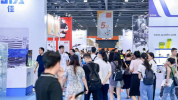MAN Truck & Bus, one of Europe’s strong brands has decided to cement its commitment to the Thai Market. As of 1st November 2019, MAN SE will appoint MAN Truck & Bus Asia Pacific – the head office of AREA APAC to be the sole distributor for Thailand to represent the company in the region. MAN SE is to work closely with local business partners to promote high quality products and fully efficient performance to support Thailand as a growth market.
Mr. Thilo Halter has many years of international experience in leading positions in various functions and industries. He has been in Asia Pacific for MAN since 2007, starting here as CFO Asia Pacific, then as Managing Director of MAN Truck & Bus Korea, and since 2015 as Managing Director of MAN Truck & Bus China.
With the ambitious targets of MAN-Simply#1 globally, Mr. Thilo Halter takes the new challenge, as Head of Sales Area Asia Pacific starting from July 1st, 2019. In an exclusive interview, Halter told Asian Trucker about their ambitions.
AT: What is the sales area handled by MAN APAC?
TH: It is, of course Asian Pacific, comprising of actually all of Asia as well as the Pacific Rim area with Australia and New Zealand in it.
Of course, the most important countries in terms of size, but not politically, are China, Korea, Malaysia, Indonesia, Australia and New Zealand with Singapore and Hong Kong also being important. Cambodia and Japan for example have not been really developed by us as markets, but that might change in the near future too.
AT: Why is it needed to have a dedicated hub to handle this region?
TH: This is a good question. We used to have a regional set-up, it was the time when I started in Asia Pacific, back in 2007. It was the regional operational headquarters for Asia Pacific. About four years ago it was decided that the regions will be dissolved. There were regions anymore. There were our subsidiaries, the NSCs (National Sales Companies) and importer companies that are handled directly from Germany. The idea was that the headquarters in Germany could deal directly with the markets, addressing their needs. That is why we took out the regional centres.
However, we realised that it doesn’t work that way. The management and decision-making power need to be close to the customer. That is why we have decided as of 1 July 2019 to establish the area. In essence, it is a regional centre, but with a different content. What is different now is that the decision making is with the region and that the regional centre is fully responsible for the P/L and the steering of the business.
There is also now a strong team, with some staff located here and some in China, plus others in Germany. This is to ensure that we can implement best practices, for instance from China, in an effective way. In addition, we have people on the Ground in Germany, who report directly report to us and ensuring that we get things done quickly and efficiently. This has never been done this way.
AT: What is the responsibility of the area office, which is based in Thailand?
TH: As the area headquarters, this is the place where all of us work on regional tasks. That means, this team here, plus the teams in China and Germany are steering the NSCs and the importers in all the countries in the area. “Steering” means that our targets are met and that the customers are taken care of. This is to be done in a fast manner and we have to ensure that have the right products for each market, as indicated through our marketing.
With “steering” also comes the support of the partners. There is a strong after-sales team that helps importers as well as our own sales offices to act fast.
AT: What are the expectations you have after this restructuring?
TH: Firstly, we expect to contribute to the growth of the brand. This area, the markets within are growing. If you look at the world however, you will notice that Europe is not growing. There is ups and downs, but it is more or less the same number of trucks sold. In APAC however, we have a huge growth potential. And of course, we want to take part in that. However, if a market is just growing, you can grow with it by just doing things the way you have always done.
That is, for us, though, not satisfying. We want to outperform the market. We want to outgrow the market and increase our market share. This is also reflected in the strategy that we coined “MAN - Simply #1”, which I will explain later.
What does the MAN – Simply #1 mean? We want to become the number one in Asia Pacific, which does not mean that we are always the market leader. However, it is an ambition, just like a soccer coach is telling the team they are going to a match to win and not to lose. The ultimate goal is to be number one in customer satisfaction. MAN wants to be number one in terms of reputation and image in the market. Also, we would want to be the number one in employee happiness. Happy employers lead to happy customers, and that IS important.
The result of all of that is hopefully that we will become the number one in market share as well, but as I said, that is not the intention of the strategy as the main goal. There is more to this, actually. As you see, the “S” in the slogan is red. This represents the sales organisation. Plus, the word “Simply” comes from our internal ambition to simplify business.
We have competitors that each have their own brand claims. They have theirs and ours is to simplify business. This, for me, is the holy grail of customer focus as it puts the customer in the first position. Our goal is to simplify the business of our customers. It needs to be made easy to deal with us, to have an easy sales process, after sales which is easy to deal with, the best uptime and ultimately, doing business with us is the easiest and therefore the most value-creating way. At the end of it, I believe, if you are the most supportive brand, the result will be success. And that is done through putting the customer at the number one. Which also aligns the organisation.
AT: That said, is the area APAC any different from other areas in MAN?
TH: Within MAN, we have five areas, whereas there are three in Europe, where our main business is. Besides that, we have one area for middle East and Latin America and the other one is APAC. I have to say that the APAC region is very different. There are different climates, different product requirements and also different products. We have different customer needs and markets are in various development stages. For instance, we have everything from EURO II to EURO VI homologation.
The first thing I have learned when I moved here (to Bangkok), is that there is no one Asia and that there are more differences between the Asian countries than there are between European countries. There are big differences in terms of habit, religion, local customs and other aspects. Thus, we need to handle each market individually. Frankly, this was not fully comprehended in our German headquarters previously. The question how you deal with each market as they are vastly different requires deep insights into each market. And these differences create a lot of complexity. Just as one example, our service staff needs to be knowledgeable in EURO II as well as in EURO VI technology. We have left hand drive and right-hand drive. Remember, in Europe, we have one legislation only while we have different legislation in each Chinese province. In summary: highly complex!
To address these challenges, we need to have a good team, comprised of a mix of diverse people from the various countries. And we need to get the Germans back home to understand this and we need this diverse team to understand the local markets. That said, we see a lot of similarities as well and that is why we have the best practice sharing initiatives in place. The basic needs of a customer is the same everywhere. And isolating this also gives us a chance to simplify our processes and what we have to change. Once I know what is important, we can copy and paste it to other countries. That is why, I am still the Managing Director of the China operations for instance.
AT: How does the implementation of the best practices work then?
TH: In China, we have tripled the business in the past three years. That means we have done the right things to push forward. These ideas and concepts we have developed there are now being presented to other markets as an offer. It is a proposal, a best practice and each NSC is to work with the local sales organisation to see if these concepts make sense. There is no point just bulldozing them through in a market where it doesn’t make sense. But if we have a good way how to organise our sales in China, then maybe we can tweak it a bit and implement it in Thailand, correct?
Another example would be the excellent vehicle hand-over process we have in South Korea. It is almost as if that is a specialty for Korea. It works so well as all customers would come to one particular place in Korea. Clients do not collect their vehicle from the dealers, but in that one space. As a result, this has become a centre of excellence for hand-over. And now we can use this as a learning hub for other countries as to how to do hand-overs. We can look at these issues and roll them out in the region.
And while you can be very good, there is always something that you can learn from others. And that keeps you humble, open and attentive.
